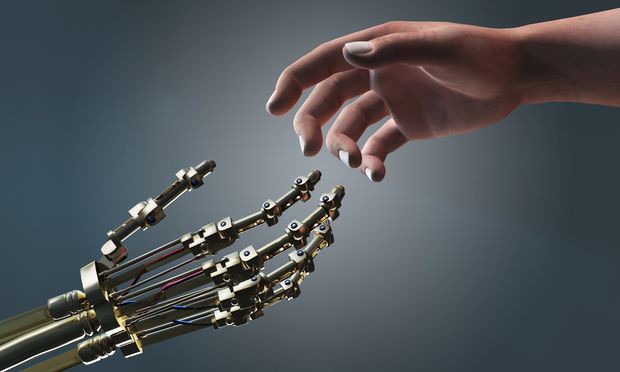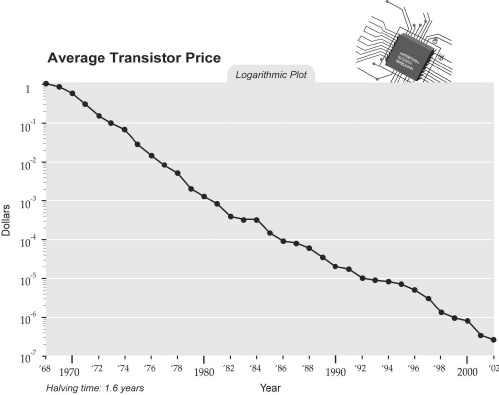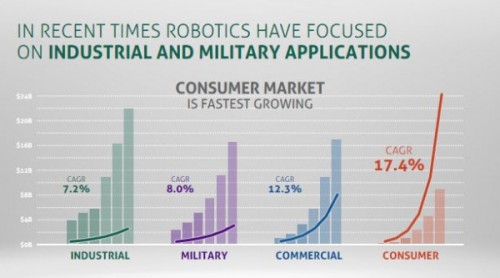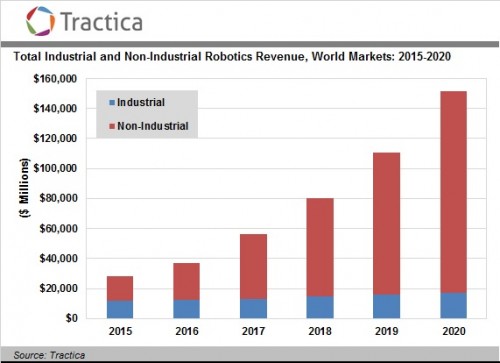Undeniably Robotics - Trends in Robotics

Humans create technology as an extension of our intelligence. We created the ladder to reach higher, the train to share goods and provide better transport, created the automobile for individual travel and computers and the Internet to share information. These devices are all somewhat extensions of ourselves, and we continue to develop technology to improve our lives and livelihood.
"Moore's law" is the observation that, over the history of computing hardware, the number of transistors in a dense integrated circuit has doubled approximately every two years.Moore's law was named after Gordon E. Moore, co-founder of Intel and Fairchild Semiconductors, who wrote a paper in 1965 stating that number of components per integrated circuit would double each year, though in 1975 he revised his paper and changed his forecast to doubling every two years. Moore's law seems to have indeed right up until 2012 where the focus seems to have shifted slightly, slowing the pace of transistor development. This prediction is an important part of history as it forecast that the size of the CPUs used in computers would be reduced from macro to micro, and their processing power would increase from that of a basic calculator to modern day supercomputers and beyond. It has partially explained why the computer industry has evolved so rapidly.
The table below shows the evolution of the transistors per microprocessor over time: Another effect is that the cost of microprocessors (which are based on transistors) has also dropped: Integrated circuits are essentially what brings robots to life; microprocessors, sensors and controllers all working together to increase a robot's intelligence. Although the "Information Era" seems to have happened so quickly, this will rapidly give way to the "Robotic Era". Some studies show that within the next few decades the number of intelligent robots will have surpassed that of the human population. It is predicted that this increase will mostly be in consumer robotics: From a recent study released by Tractica, we see that around 6.5 million robots were sold in 2015, which is approximately one million more than last year. They project that just over 100 million robots will be sold worldwide in the next 5 years (the number of robots sold will have risen to around 30 million annually). Domestic robots will make up a large percentage of these numbers, but the fastest growth will occur in robots used for personal assistance. Another example is that predictions are increasing from year to year; a very complex trend some might say. The next graph is from Japan's Robotic Association which was included to our Trends in Robotics blog post from 2011. The more recent graph below from Tractica shows new numbers. In 2015 the robotics industry currently stands at around $28.3 billion worldwide and it is predicted to surpass $150 billion by 2020. This brings us to the question of why robotics? Robots were created to the increase knowledge, liberty and security of humans, helping us to live better and more comfortable lives. Robots take care of menial or repetitive tasks and chores, allow us to perform remote surveillance or operations and relieve us of other worries or obligations. For the next five years the fastest growing market in robotics will likely be personal assistance robots; this can be in the form of a car which can drive us to work autonomously, to robots which help the elderly out of bed in the morning, help them get dressed, shop for groceries and cook their meals. Robots which answer the door bell, tell us not to forget the milk on our way home or even deliver the milk to your home are likely all not far off. The possibilities are endless. Little do we know where all this technology will bring us, though one thing for certain: it will happen really fast and the momentum has already begun. There are many benefits to teaching children about robotics at an early age. We can only imagine that once the number of intelligent robots surpasses the number of humans there will be a big demand for jobs and careers in robotics, including inventors, engineers and technicians. With this many robots, there will also be the need for specialists able to repair or recycle them. Kids these days seem to be hooked on and adapt with technology. Obviously the Internet and the computer have contributed significantly to this trend and have been at the forefront of the information age. Computers and robots are more interactive, and can be personalized to suit the child, thus opening the door to increased creativity and curiosity. Children are learning more than ever before, more quickly, and most important of all, are having fun doing so. Here is a short video from FIRST Robotics about children and robots:"The technology at the leading edge changes so rapidly that you have to keep current after you get out of school. I think probably the most important thing is having fundamentals." - Gordon Moore
Thank you Dean Kamen for your commitment in promoting technology to children. This philosophy is also a major part of our vision here at RobotShop: promoting the use of robotics use towards positive ends, thus allowing humanity to build a better world. We have many products for education in our Robotics Education category and are working hard to increase this selection.
"Sporting competitions seem to be what we obsess over, frankly. So if we can put engineering, science, technology into a format of healthy, fun competition, we can attract all sorts of kids that might not see the kind of activity we do as accessible or rewarding." - Dean KamenRay Kurzweil describes his law of "accelerating returns" which predicts an exponential increase in technology like computers, genetics, nanotechnology, robotics and artificial intelligence. He says this will lead to a "technological singularity" around 2045, which represents a point where progress is so rapid it outstrips humans' ability to comprehend it. But will this really happen? Children of today and the next generation to come will be smarter and more capable than humanity has ever seen. It is evolution in the making and we are there to witness it: the Robotic Era and the dawn of a new age. References: http://www.kurzweilai.net/futurism-the-dawn-of-the-singularity-a-visual-timeline-of-ray-kurzweils-predictions https://en.wikipedia.org/wiki/The_Singularity_Is_Near http://www.firstroboticscanada.org/main/ http://snip.ly/u804#http://www.iflscience.com/technology/five-reasons-teach-robotics-schools https://www.tractica.com/newsroom/press-releases/global-robotics-industry-to-surpass-151-billion-by-2020/ https://www.tractica.com/newsroom/press-releases/nearly-100-million-consumer-robots-will-be-sold-during-the-next-5-years/ https://en.wikipedia.org/wiki/Moore%27s_law http://www.singularity.com/charts/page60.html http://www.howtolearn.com/2013/11/how-technology-makes-kids-smarter/
Thanks for helping to keep our community civil!
Notify staff privately
You flagged this as spam. Undo flag.Flag Post
It's Spam
This post is an advertisement, or vandalism. It is not useful or relevant to the current topic.
This post is an advertisement, or vandalism. It is not useful or relevant to the current topic.
You flagged this as spam. Undo flag.Flag Post









